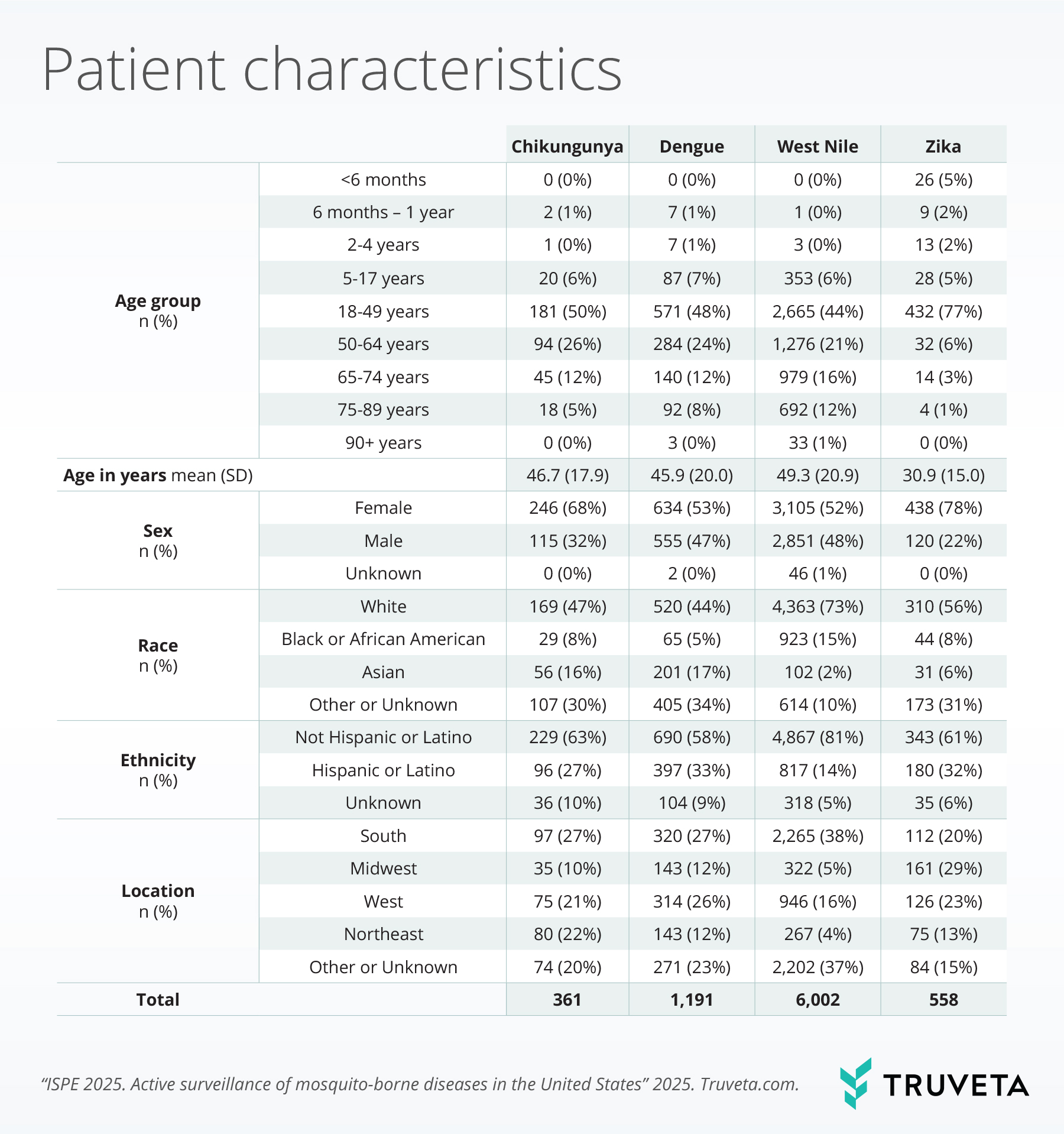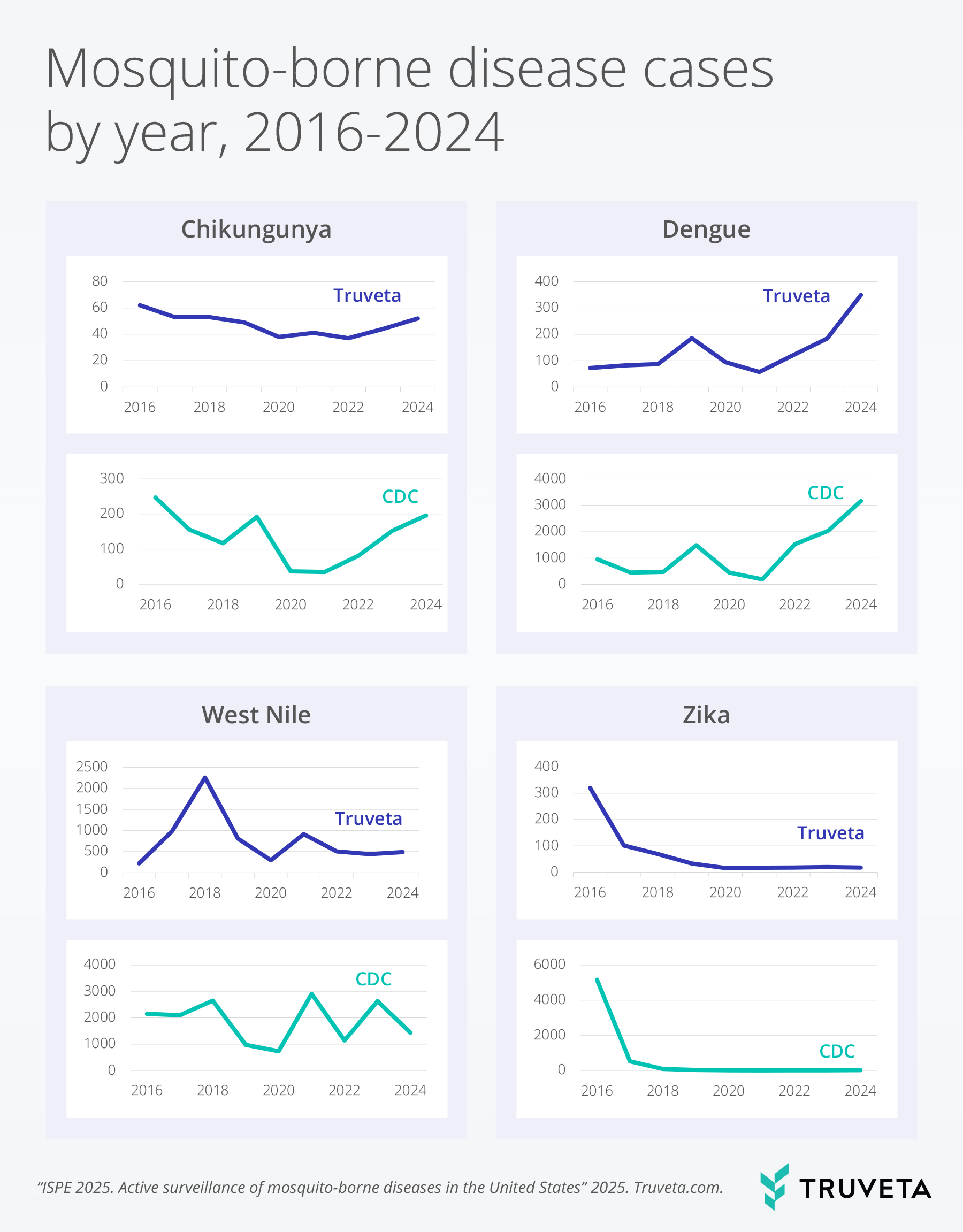Authors: Katie Kendrick, MPH ⊕Truveta, Inc, Bellevue, WA, Amy Sullivan, MS ⊕Truveta, Inc, Bellevue, WA, Sunny Guin, PhD ⊕Truveta, Inc, Bellevue, WA, Agnes Pastwa ⊕Truveta, Inc, Bellevue, WA, Sarah Platt, MS ⊕Truveta, Inc, Bellevue, WA
- Truveta Data is well-suited to support real-time active surveillance of infectious diseases, as illustrated by trends in the chikungunya, dengue, West Nile, and Zika viruses.
- Our findings closely align with national surveillance data from the CDC, demonstrating the reliability of electronic health record (EHR)-based insights.
- These results highlight the potential for rapid detection of outbreaks to inform timely public health action.
This blog is an extension of our poster presented at the 2025 International Society for Pharmacoepidemiology Annual Meeting (ISPE), titled Active surveillance of mosquito-borne diseases in the United States.
Mosquito-borne diseases have long posed a threat to public health in the United States, with notable outbreaks of West Nile virus and Zika virus in the past decade. Factors such as climate change, land use, and increased travel have created conditions that may accelerate the spread of these diseases. While states and territories report mosquito-borne disease cases to the Center for Disease Control and Prevention (CDC) National Notifiable Diseases Surveillance System (NNDSS), reporting delays and undercounting of cases can hinder rapid response efforts.
Our study set out to answer a key question: Can Truveta Data be used to measure, in real time, the trends of mosquito-borne disease cases and detect patterns consistent with national data?
The results show that Truveta Data not only aligns closely with CDC-reported trends, but also offers the timeliness needed for proactive public health action.
Methods
We conducted a retrospective analysis using Truveta Data, which provides daily updated, de-identified electronic health record (EHR) data from leading US health systems, including hospitals and clinics, representing over 120 million patients.
Patients with a recorded diagnosis or positive laboratory test for chikungunya, dengue, West Nile, or Zika virus between January 1, 2016 and December 31, 2024 were included in the study.
Four disease-specific cohorts were created and examined for demographic characteristics, geographic distribution, and annual trends in case counts. Patterns observed in Truveta Data were compared against national case counts reported in the CDC NNDSS (1,2).
Results
Between 2016-2024. we identified:
- 361 patients with chikungunya
- 1,191 patients with dengue
- 6,002 patients with West Nile
- 558 patients with Zika
Patients with West Nile virus had the highest median age at 49.3 years, while patients with Zika virus had the lowest at 30.9 years. The majority of patients were female across all diseases, particularly patients with Zika, who were 78% female. Patients with West Nile virus were primarily White (73%) and non-Hispanic or Latino (81%), while patients with dengue virus or Zika virus had the highest likelihood of being Hispanic or Latino at 33% and 32%, respectively. Patients were identified across all regions of the US, with 38% of patients with West Nile virus in the South.

Note: Patients are counted once per disease based on the first diagnosis or positive test.
Yearly trends
- Chikungunya: Consistently low case counts across the study period
- Dengue: Peak in 2019, with consistent year-over-year increases from 2021-2024
- West Nile: Peaks observed in 2018 and 2021
- Zika: Peak in 2016, followed by steady, low case counts from 2017- 2024
Across all four diseases, observed patterns in Truveta Data were relatively consistent with trends reported in CDC NNDSS data, including national outbreaks.

Discussion
Our findings demonstrate that Truveta Data can serve as a robust source for real-time surveillance of mosquito-borne diseases in the US. The strong alignment with national data underscores the reliability of EHR-based insights for tracking emerging infectious disease threats. These findings are consistent with data accessed on June 2, 2025.
Citations
- Centers for Disease Control and Prevention. National Notifiable Disease Surveillance System, Annual Summary Data 2016-2022. Available at http://wonder.cdc.gov
- Centers for Disease Control and Prevention. National Notifiable Diseases Surveillance System, Weekly Tables of Infectious Disease Data. Atlanta, GA. Office of Public Health Data, Surveillance, and Technology. Available at: https://www.cdc.gov/nndss/data-statistics/index.html

